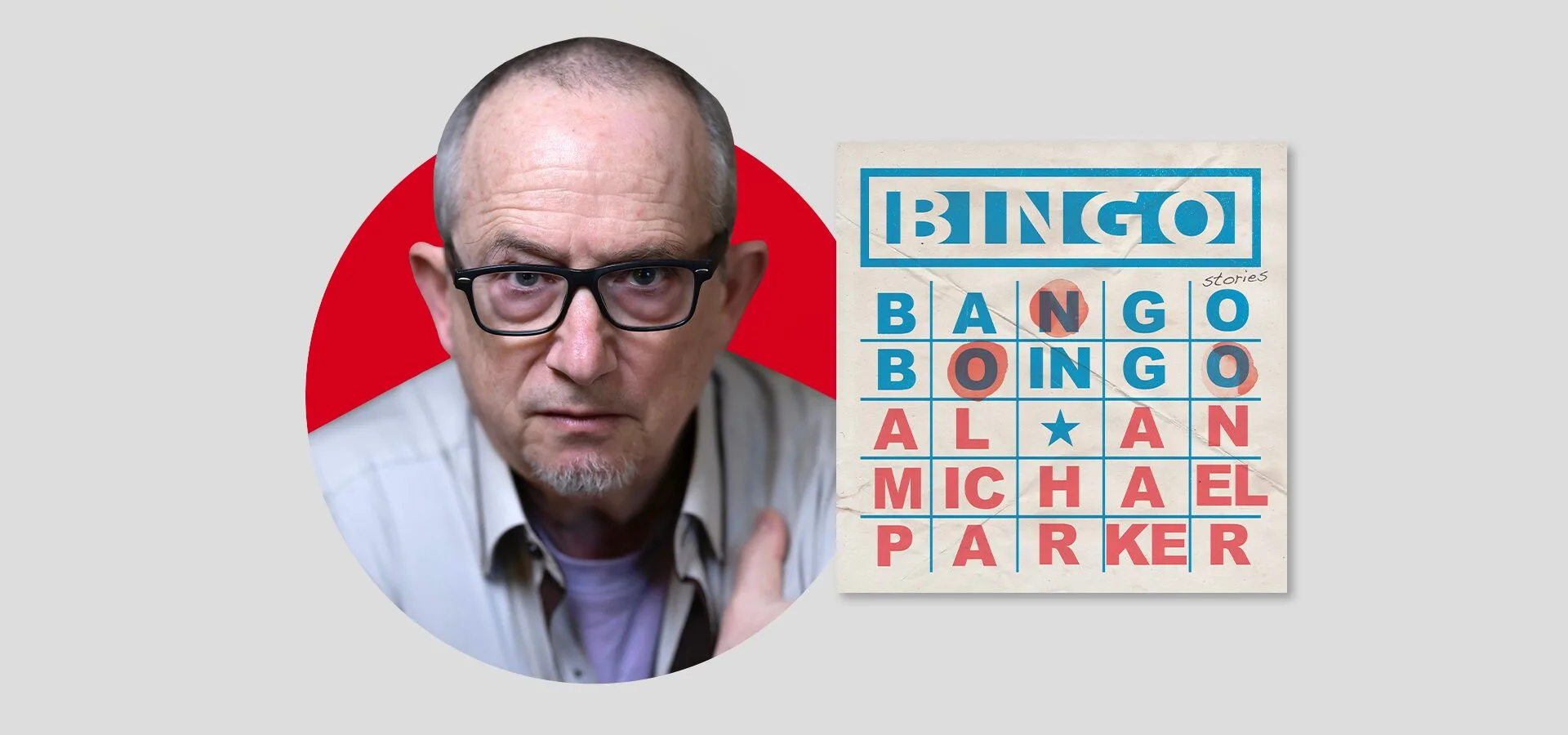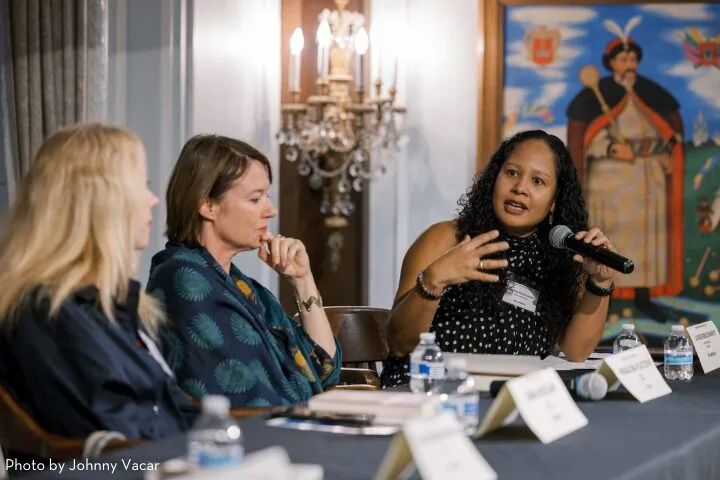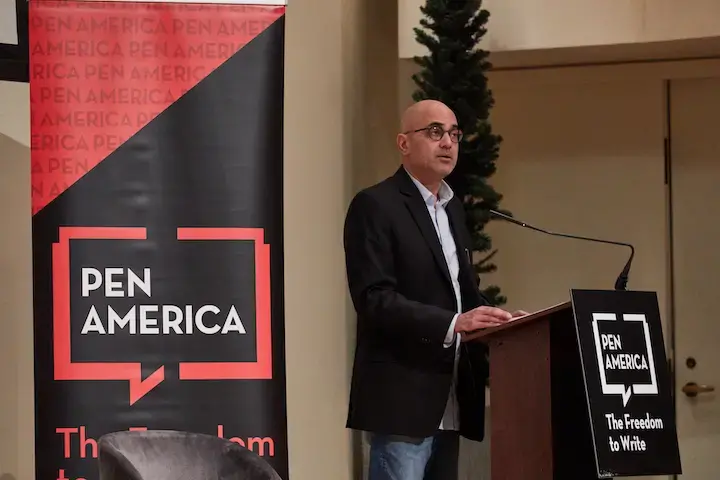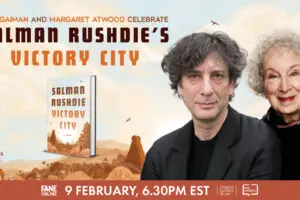
Alan Michael Parker | The PEN Ten
In Bingo Bango Boingo (Dzanc Books, 2025), Alan Michael Parker uses the form of a Bingo card to take flash fiction to another level. Through a set of 25-square grids, Parker crafts narratives motivating readers to take individual journeys to understand the pieces–or clues–before them. There is even a section of the book with partially filled cards encouraging readers to directly engage with the stories. In these bits of dialogue, quotes from books and songs, random names, and pop culture references, Parker’s method of storytelling challenges the linearity that often accompanies fiction. In the end, Parker concretely demonstrates that there is no one way to read a story.
In this interview with Malcolm Tariq, program director of PEN America’s Prison and Justice Writing Program, Parker discusses what draws him to flash fiction and how writing stories through a structured form taught him to think differently. He also answers the challenge of creating a new-prompted Bingo card. (Bookshop, Barnes & Noble)
Do you have a personal connection to Bingo? What inspired you to write a book incorporating its structure into a literary form?
For years, I had a blank Bingo card on my desktop, and I didn’t know why. During Covid, I began to question my art-making and writing, and I was wondering about meaning (and death) and what I might make that could change how we experience art. An accessible form, a new form with rules you already know… the Bingo card seemed ideal as a way to think differently about how narrative works (at least in my head). So I started to play with filling in the squares and making all of the information add up to be a single story.
Not that I went to Bingo halls as a kid, or did more than own a multi-game box (chess, checkers, Bingo, and maybe Parcheesi?), but who doesn’t want to be a kid, or more aptly, who never stopped being one?
As a poet, I enjoy flash fiction because it feels like I’m reading a concentrated short story with poem-like qualities. What draws you to flash fiction? How would you describe flash fiction to someone new to the genre?
Well, I’m a recovering poet, so your affinity makes sense to me as well.
In flash fiction, compression matters, as does the opportunity for lyricism. But flash isn’t poetry, given that the sentences in a work of flash fiction are the primary units of meaning, and the words aren’t dependent upon their prosody, and a story’s not a collocation of lyrical ideas.
Welcome to flash fiction, I say: here’s a story in fewer words than most; where meanings compress; where the pressure on each word to matter increases; and where you get to infer, and fill in information you might consider part of the richness of reality.
I was wondering about meaning (and death) and what I might make that could change how we experience art. An accessible form, a new form with rules you already know… the Bingo card seemed ideal as a way to think differently about how narrative works (at least in my head).
What was your process for writing and designing the bingo cards? How do you imagine readers engaging with them?
In this sense, it’s kind of the opposite of how you might work on a jigsaw puzzle. Rather than begin around the corners and edges, I start with a provisional title and the “free square” as concepts, penciling in some temporary information, and then move to squares that make fewer possible Bingo lines (again, not in any of the four corners). Once I get a sense of the details that will characterize the narrative problem, or the protagonist, or the story’s conflict, I move around the outside of the square, and work on the most important boxes. Then it’s the four corners—because each of those squares can contribute to three Bingo lines rather than only two. They’re the most important. Finally, I see if the title and the “free square” content need revising.
That’s the first draft. Nineteen or so drafts later, something starts to work. And then my great editor, Michelle Dotter at Dzanc Books, shows me what I haven’t seen.
I imagine that readers start with the title, read the upper left and maybe horizontally a bit, read the text in the “free square,” then start jumping around, and finish their story in the bottom right corner. But I’m only imagining what the reader does, as always.
I loved finding the notes section at the end of the book because it reads as a long list of references. It was here that I fully realized the range of topics and interests that appear in the cards, from Cyndi Lauper to Mother Maria Su and James Baldwin. I’m sure some of these references you were very familiar with, but was there any information you learned while writing these stories? If so, what did research or assembling this new information look like for this project?
Oh my, I learned tons. All of those notes… they’re really important to how I think about the stories, and the stories in this historical moment, and the various ideas that matter to me. Plus, research lets me get my nerd on.
Years ago, I realized that for my work to be in the world, and for me to be made happy by making work, I had to stop compartmentalizing myself as a person. I love reading, cooking, Aristotle, minor Norwegian painters, who invented what cool thing, Death Core bands, and ice hockey. As an artist, I want to be a whole man: that’s the impulse the notes document as well.
There are a few bingo cards that I returned to more than others. One of my favorites, “Doug and Linda’s Orgasm Diary,” is seemingly about sex but becomes more–for me—about the accumulated intimacy and personal history that can only be remembered between those two people. I’m curious: Do you have a favorite card or two from the book?
I like different cards for different reasons, some for the personal data I slip into fictional characters’ lives, some for how three or four Bingo lines in the same card somehow seem to contradict each other (as narrative data) but also seem to be present and true.
The ones that offer information that appears like it’s a non sequitur but then unveils a particular reading—those might be my favorite formally. (For example, that’s how the recurrence of the name “Sandra” works in “Change Your Life Bingo.”) But then there are a few more “poetic” cards, such as “People Floating Away Bingo,” that compile stories based on non-realist principles or a lyrical premise; those stories let me add a few boxes of text that rely on pure make-believe. Doing so thrills me.
Years ago, I realized that for my work to be in the world, and for me to be made happy by making work, I had to stop compartmentalizing myself as a person.
Did working on this book change your relationship to writing? I’m particularly thinking of the bingo cards, and the deliberate choices of what items went into them or were left out.
My Bingo card stories kind of have two titles, the title at the top and the text I put in the “free square.” To consider that concept in terms of more traditional storytelling has changed my relationship to writing. What’s the title of a story, and then, what’s the story’s “secret title,” i.e. what would be the equivalent of the “free square” in a traditional narrative, through which so many narrative ideas must pass? It’s a kind of visual thinking I’m applying elsewhere.
Also, Bingo seems like such an easy game, but as a narrative project, it’s amazingly hard (because one must always resist simply making lists). More important for the reader, even the most elliptical Bingo card story can be easier to read because they know how to play Bingo, and thus, how to put the story together. I love that the reader has easy access to these unconventional stories—and I’m trying to see how other art I’m doing, including more conventional writing, can be just as accessible.
Moving from the Bingo cards to flash fiction, and to my cartoons, and to long-form prose projects, I think I’m more aware now of the power of the non-plot points as narrative data. Poetry taught me that, sort of—at least in terms of symbolizing and signifying. But I think I’ve learned differently as a result of this new work.
How did you become a writer? Why are you still a writer?
Well, I’m a man made of words. Writing has long been my way of learning, of learning what I think, and making knowledge.
Why still? Obsession, self-esteem, fanaticism, passion… and I feel like I have more books to write, and art to make. It feels like I’m just starting.
Moving from the Bingo cards to flash fiction, and to my cartoons, and to long-form prose projects, I think I’m more aware now of the power of the non-plot points as narrative data.
What writers have influenced your art the most?
Let’s try this alphabetically: Chinua Achebe, Dante Alighieri, Margaret Atwood, James Baldwin, Alison Bechdel, Elizabeth Bishop, Jorge Luis Borges, Octavia Butler, Roz Chast, Anton Chekhov, J. M. Coetzee, Rachel Cusk, Italo Calvino, Don Delillo, Philip K. Dick, Rosario Ferré, Paula Fox, Max Frisch, Nadine Gordimer, Dashiell Hammett, Franz Kafka, Gabriel Garcia Marquez, Bernard Malamud, Alice Munro (ouch), Lady Murasaki, Grace Paley, Vasko Popa, Claudia Rankine, George Saunders, Susan Sontag, Art Spiegelman, Laurence Sterne, Elizabeth Strout, Wislawa Szymborska, Ngũgĩ wa Thiong’o, Eudora Welty, Colson Whitehead.
What’s the worst piece of advice you’ve ever received on writing, or about having a writing or publishing career?
Save your good ideas for the next book.
Write what you know.
Challenge: This bingo flash fiction is titled, “If It Can Happen to Alan Michael…” What are some items in that card?
Dang, that’s hard. How about: “Get fired,” “Be a dancer,” “Don’t be a dancer,” “Teach film,” “Help!,” “Smash your head body-surfing,” “Make up stuff,” “Happy marriage,” “Unlearn capitalism,” “The mind is its own place (John Milton),” “Holy shit, he what?”
Alan Michael Parker is the author or editor of nineteen books, including the novels Christmas in July and The Committee on Town Happiness, both with Dzanc Books. He holds the Houchens Chair at Davidson College, where he chairs the Department of English. His awards include the NC Book Award, three Pushcart Prizes, two Best American Poetry selections, and the Fineline Prize. A book reviewer for The New Yorker for nine years, he has judged the 2021 National Book Award in Fiction, as well the 2024 PEN/Faulkner Award in Fiction.








